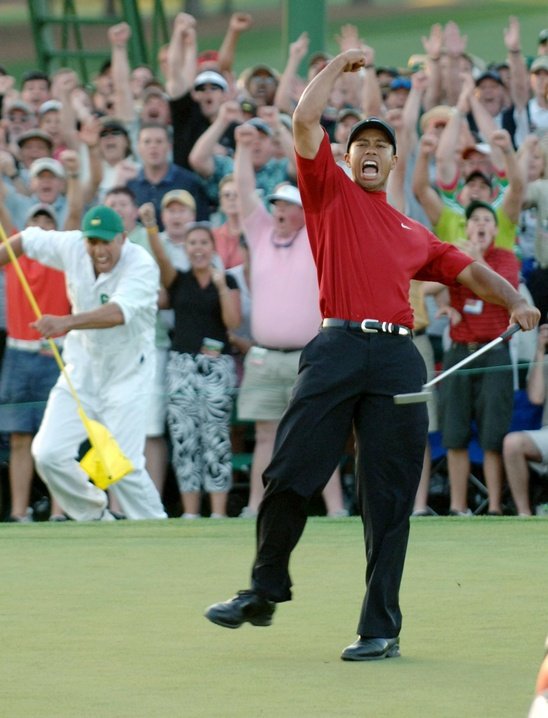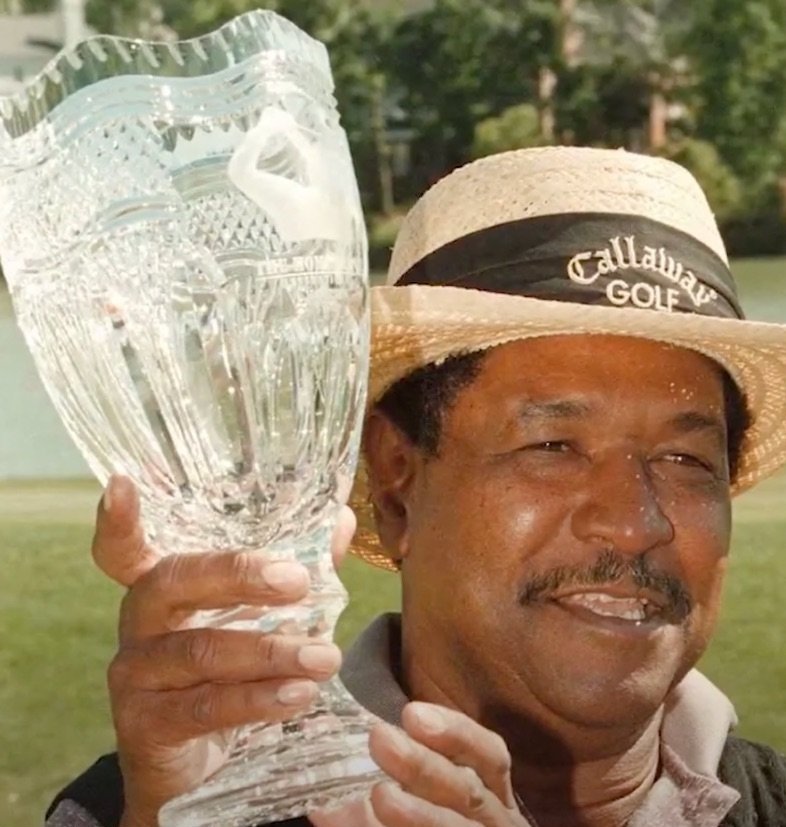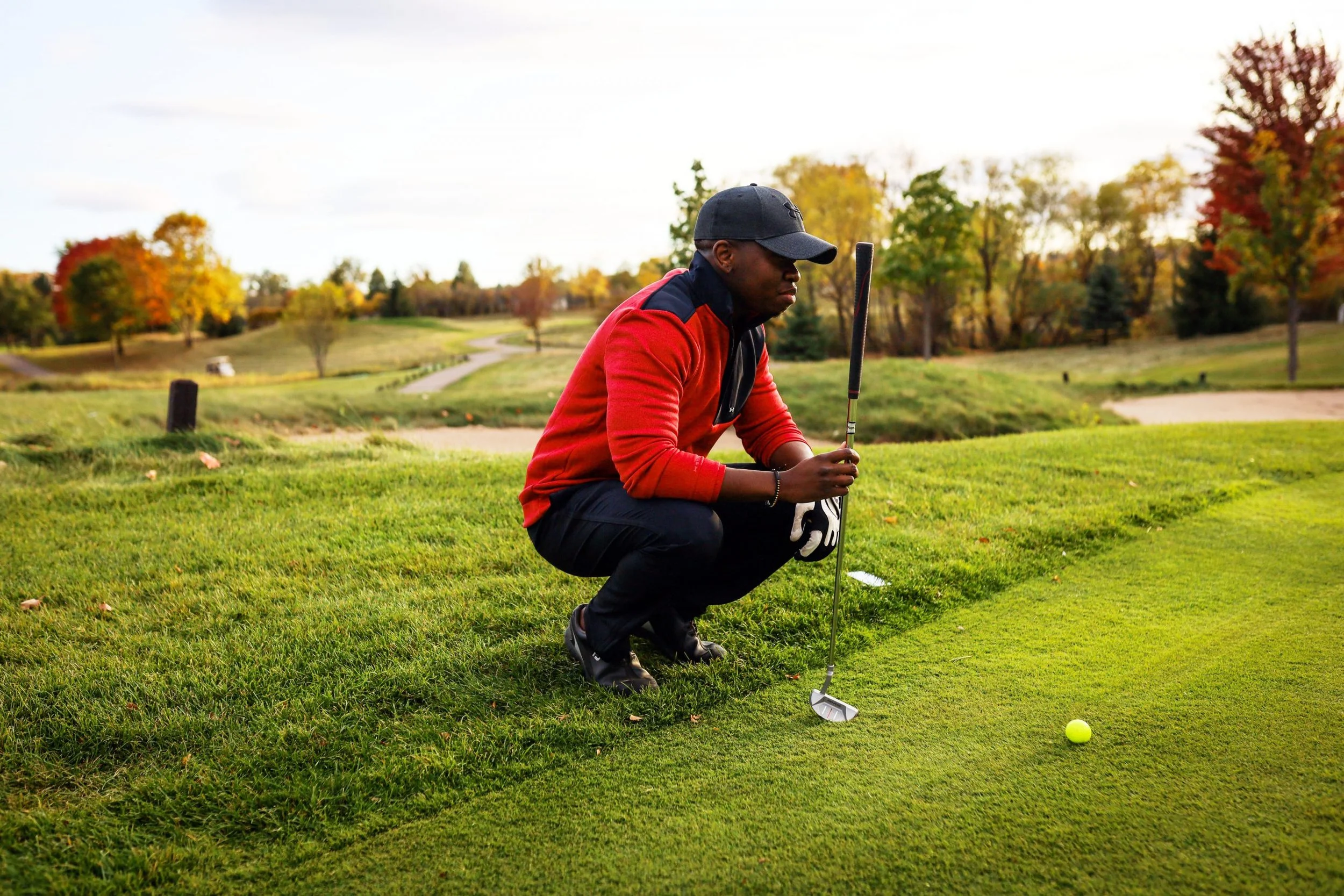The Master’s: The Legend of Black Caddies in Golf’s Greatest Event
By Leroy Adams
A group of Black caddies sit with Arnold Palmer during the 1965 Masters.
Our story starts in a two-bedroom apartment on the second floor with the smell of fried pork chop, steamed black-eyed peas, and neck bones-soaked collard greens beneath our nostrils, filling the room and breaking the fandom tension with smells of Sunday comfort.
My pop is locked in on the television. Tiger Woods is in a one-hole playoff against Chris DiMarco, attempting to win his fourth Masters. "Tiger got this man. He's come up short the last two years, but he's been on his game today," my pops said as Tiger walked up to hole 16.
The Greatest Shot In Golf History
Tiger Woods celebrates after his historic shot on the 16th hole in the 2005 Master’s.
Before that Sunday, I had never seen a grown man kiss a TV screen. Here was a guy with who chased my brothers and me when we took a sip of juice straight from the carton, but you kissing TV screens! The nerve, anyway, I digress.
So Tiger walks up to the tee for the 16th hole and with the graceful force his swing is known for, he lets it rip. The ball flies, but Tiger yanks it left and misses the green. "Dammit, Tiger!" my pops scream.
"Bob, lord have mercy.", my mom shouts as she shakes her head.
For non-golf enthusiasts, this means Tiger's ball did not land on a good field of play, which means he has to perform a miracle to get the ball in the pin on his next hit.
And a miracle ensues.
The world is quiet—my pop's face is five inches from the television. My mom - ready to fling her shoe at him if he shouts again. Tiger approaches his ball, he swings, and he lands on the green and the slope carries the ball downward toward the yellow pole before stopping at the edge of the hole - where it would stay for three long seconds.
The whole world paused for those three seconds before the ball eventually rolled over causing Tiger, his caddie, and the world to erupt in celebratory chaos.
What pushed it over? It had to be my pops breathing on the screen.
I looked over to find my pops passed out on the floor because he had just witnessed the greatest shot in golf history. He always watched Tiger's matches. If he were with us today, he'd be gearing up to watch him play in The Master’s this weekend.
Black History in Golf
A group of Black caddies working the greens with golfers.
Although we would take summer trips to Georgia, he never visited Augusta, and with limited financial resources, he could only dream of actually going to the masters. He would always talk about it, even saying one day he wouldn't mind being a caddie just to be there.
I never understood why my pops loved golf so much. In our community, football, basketball, and track were not only the sports that Black people thrived in but also avenues to a life out of impoverished conditions. In short, until Tiger came along, the sport of golf wasn't a "Black" thing, much like the now incomprehensible idea that "Black people don't travel like that."
National Geographic traveler and founder of the ABC Travel Greenbook App, Martinique "Marty" Lewis, with her recently produced "Black Caddies of Augusta National," not only reminded me of those special Sundays with my pops but also of the long and untold history that Black caddies have on the sport.
Walter "Roundhead" Newton shares the history of Black caddies with Marty.
The short video tells the significant yet often overlooked history of black caddies in the prestigious Masters Tournament in Augusta, Georgia. Since its inception in 1934, the tournament has been a symbol of golfing achievement. However, behind the scenes, black caddies like Iron Man, Cemetery, Roundhead, Cigarette, and Burnt Biscuit played a crucial role in the sport's legacy, showcasing resilience, talent, and dedication despite being viewed as holding a low-skilled job.
We first meet Walter "Roundhead" Newton, who started caddying at the age of 11 at the Augusta Country Club—a white-only establishment—where he would make between $5-6 every weekend before "graduating" to the Augusta National, where he could make "a nice lil piece of change" up to $16 every weekend, eventually learning how to golf himself.
"Over at Augusta Country Club, they had a vacation field, and you got thirty caddies around. They got sticks, and it's an open field. While waiting to get a bag and go caddy, they would play golf up and down the field. You watched the older guys who were five and six years older than me. You watched them, and as you grew up, your time came. So now I started and grew into it."
Marty then introduces us to a living legend, Mr. Jim "Big Boy" Dent (no relation to Big Boi from the film "Who's Your Caddy?"), a decorated golfer from Augusta. After giving us an overview, accompanied by images from his youth of him playing on the greens, Big Boy Dent shares how the demographics of the caddie had changed because caddies can make more than a "lil piece of change" today, "When I played, 85% of the caddies were Black, and 15% were white when I went to the tour. Now, it's 1% Black and 99% white because the money changed."
Jim “Big Boy” Dent celebrates a win.
In the next scene, Roundhead Newton shares his experiences on how the ability to make more money ushered in a wave of white caddies replacing skilled Black ones: "I don't think now there are four black caddies on tour. At one time, I could tell you 10, 12, 15 were out there, and they were winners. A guy from my neighborhood named Leroy Shultz. I think he won about ten times."
He continues by sharing how Black caddies, with their local knowledge of the greens, are simply irreplaceable and valuable as the viewer is treated to stills of Black caddies meticulously studying the field, preparing to advise the golfers on club selection and ball placement, "Local knowledge, you just can't beat it. These guys [Black caddies] been caddying on this green even before The Masters was playing. They did this every day; they knew how to read these greens."
Black Dollars in Sports
Two women enjoying a game of golf.
Marty's work and my pop's fandom are beautiful reminders of the presence of Black people in previously segregated areas of American culture - like golf. The stories of legends like Walter, Jim, and Leroy remind us that history is often written to exclude Black people who worked to pave the way for future generations while receiving little pay and even less recognition than their counterparts.
For sports marketers today, the die-hard fandom of my pop's is a reminder that Black people, then and still today, are not just spectators but a major untapped consumer market in the sports industry. A study published in 2020 by NYU SPS Preston Robert Tisch Institute for Global Sport, found that African Americans identified as sports fans more than any other racial group. Moreover, the results indicate African Americans significantly more identified as sport spectators than Caucasians, Asian Americans, and Native Americans. The same can be said for team identification, where African Americans identified with their favorite team (or athlete) more than their racial counterparts. With buying power expected to grow to $1.8 trillion by the end of 2024, African American represent a consumer market the sports industry - including golf - would be insane to ignore.
A golfer studies the field before his next swing.
I never had the opportunity to ask my pops why he loved golf so much. Was it simply because he witnessed a living legend in Tiger Woods, like him, a Black man, during his prime, or was he aware of the long history of Black caddies and viewed Tiger Woods as a culmination n of that legacy?
I'll never know, but I enjoyed watching him locked in during The Master's Weekend. Like the Black caddies, he could read the greens, suggesting which club to use and where to place the ball. Perhaps convinced Tiger could hear him, he would relay his wisdom to the television, ready to join him in his trademark fist pump, like he eventually did when Tiger landed that historic shot on the 16th hole.
You can watch Marty's "The Black Caddies of Augusta National" on the ABC Travel Greenback YouTube page. Click the link here.







